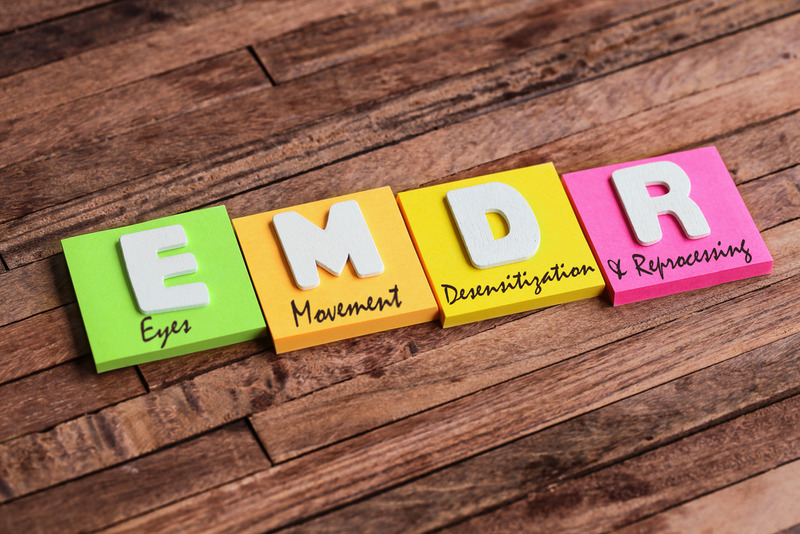It is commonly believed that severe emotional pain often takes a long period of time to heal. In traditional “talk” therapy, the individual is guided by the therapist each session into unlocking these emotions through words. Talking about the trauma can sometimes be painful and retraumatizing. Here at Trauma and Beyond Center ®, we offer the EMDR Treatment Program in addition to traditional psychotherapy in an effort to process traumas from all aspects of being body, mind, and feelings, without retraumatization.
What is the EMDR Treatment Program?
According to the American Psychological Association, EMDR is a structured therapy that encourages the patient to briefly focus on the trauma memory while simultaneously experiencing bilateral stimulation (typically eye movements or tappers) which is associated with consolidation and integration of traumatic memories. It was initially developed in 1987 for the treatment of post traumatic stress disorder (PTSD). It is now widely used with developmental / complex trauma treatment. The length of treatment for shock treatment versus complex-PTSD will differ vastly.
It basically takes the assumption that the mind can heal from psychological trauma in the same way that the body heals from physical trauma. In the same way that when you get a cut on your skin, your body works to heal the wound. But if repeated injury or a blockage irritates the wound, it will fester and cause additional pain. In the same way that when there’s something that’s mentally blocking you from healing, it causes additional pain. And once this block has been removed, then the healing can begin.
What Happens During Treatment?
According to the EMDR Institute, the treatment program has eight phases:
Phase 1
The first phase is a history-taking session(s). The therapist assesses the client’s readiness and develops a treatment plan. Client and therapist identify possible targets for EMDR processing. These include distressing memories and current situations that cause emotional distress. Other targets may include related incidents in the past. Emphasis is placed on the development of specific skills and behaviors that will be needed by the client in future situations. At Trauma and Beyond Center ® we use this phase for stabilization and resource building.
Initial EMDR processing may be directed to childhood events rather than to adult onset stressors or the identified critical incident(s) if the client had a problematic childhood. The length of treatment depends upon the number of traumas and the age the trauma occurred whether its one time incident or complex PTSD. Those with complex trauma may require a longer treatment time.
Phase 2
During the second phase of treatment, the therapist ensures that the client has several different ways of handling emotional distress. The therapist may teach the client a variety of imagery and stress reduction techniques the client can use during and between sessions. Compared to talk therapy alone, EMDR therapy can produce rapid and effective changes while the client stays in the window of tolerance remaining regulated during and between sessions.
Phases 3-6
In phases three to six, a target is identified and processed using EMDR therapy procedures. These involve the client identifying three things:
- The vivid visual image related to the memory
- A negative belief about self
- Related emotions and body sensations.
In addition, the client identifies a positive belief. The therapist helps the client rate the positive belief as well as the intensity of the negative emotions. After this, the client is instructed to focus on the image, negative thought, and body sensations while simultaneously engaging in EMDR processing using sets of bilateral stimulation. These sets may include eye movements, taps, or tones. The type and length of these sets is different for each client. At this point, the EMDR client is instructed to just notice whatever spontaneously happens.
After each set of stimulation, the clinician instructs the client to let his/her mind go blank and to notice whatever thought, feeling, image, memory, or sensation comes to mind. Depending upon the client’s report, the clinician will choose the next focus of attention. These repeated sets with directed focused attention occur numerous times throughout the session. If the client becomes distressed or has difficulty in progressing, the therapist follows established procedures to help the client get back on track.
When the client reports no distress related to the targeted memory, (s)he is asked to think of the preferred positive belief that was identified at the beginning of the session. At this time, the client may adjust the positive belief if necessary, and then focus on it during the next set of distressing events.
Phase 7
In phase seven, closure, the therapist asks the client to keep a log during the week. The log should document any related material that may arise. It serves to remind the client of the self-calming activities that were mastered in phase two.
Phase 8
The next session begins with phase eight. Phase eight consists of examining the progress made thus far, and working through future templates. The EMDR treatment processes all related historical events, current incidents that elicit distress, and future events that will require different responses
Healing from severe stress and trauma is difficult and will take its toll on your entire well being, both mentally and physically, if not properly and thoroughly addressed. Luckily, there are already several treatment plans that are available to help you move on. We here at Trauma and Beyond Center ® offer the EMDR treatment program and a variety of other treatment programs that will lead you towards healing and happiness.
If you feel that you need help managing your anxiety, depression, or PTSD, call us and we will be happy to speak to you about our EMDR treatment program and all of our treatment programs for anxiety, trauma, and other mental health issues. Call us at 818-651-0725.


